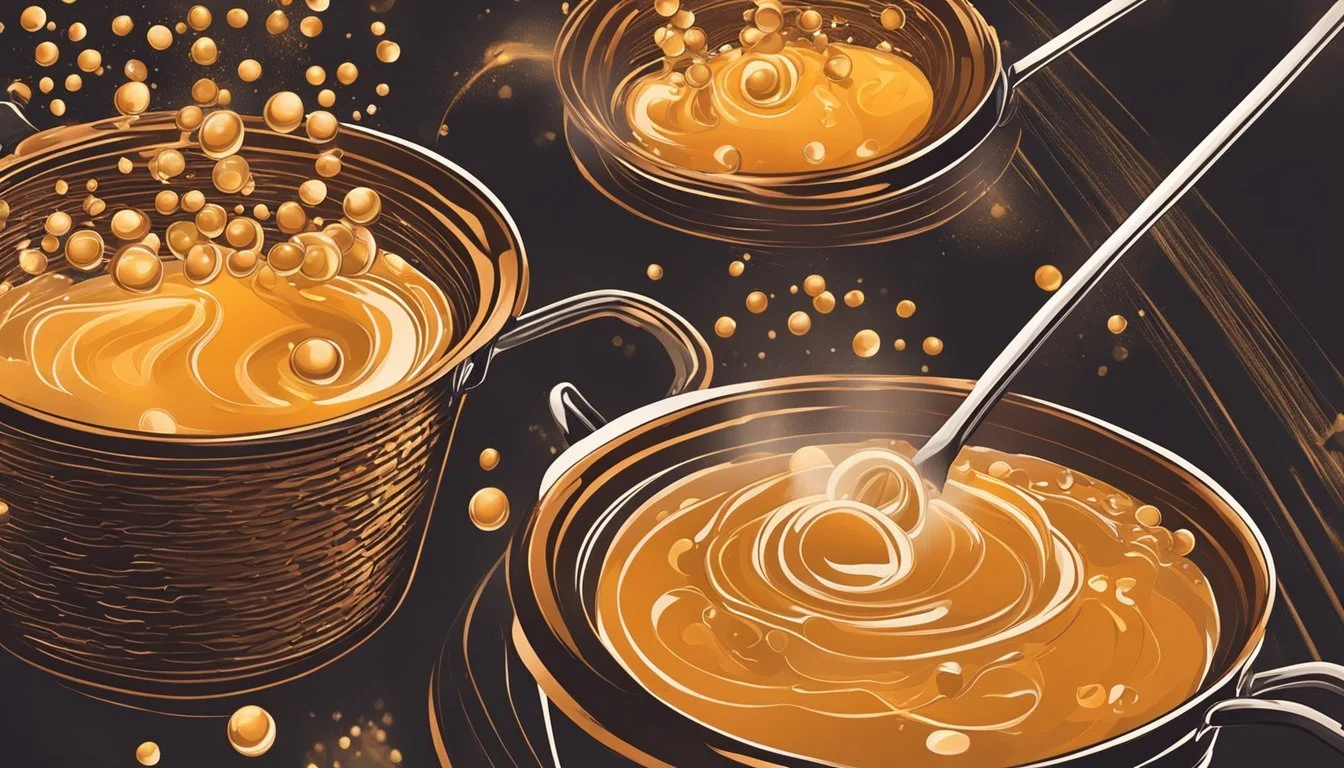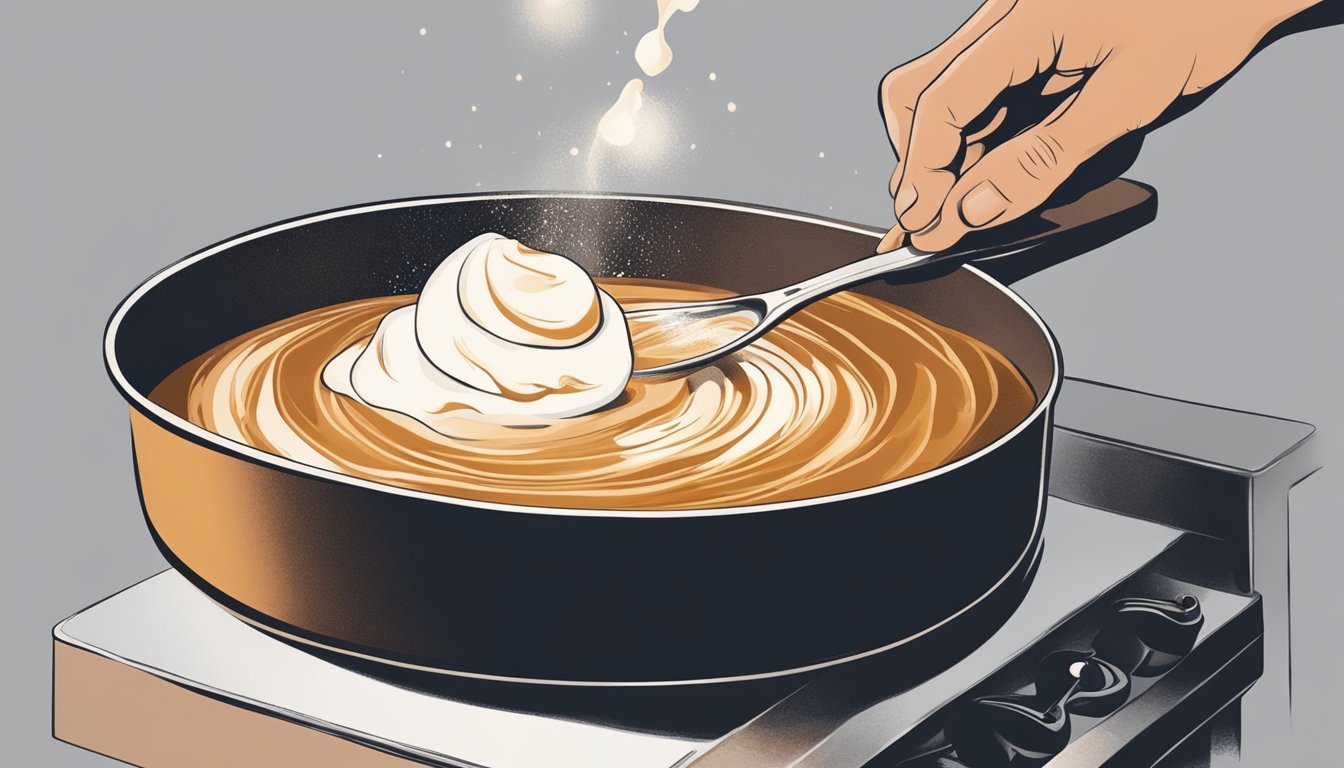Saving Burnt Toffee
Effective Strategies to Remove Bitterness and Restore Flavor
When making toffee, the perfect blend of buttery sweetness can sometimes go awry, leaving a chef with a separated or burnt batch. Such mishaps are not uncommon in the delicate process of candy making, where high temperatures and precise timing collide. But a less-than-perfect toffee doesn't necessarily mean a waste of ingredients and effort. Understanding the science behind these confections and employing the right techniques can turn a kitchen disaster into a salvaged delight.
Separation is one of the primary challenges when preparing toffee. This problem occurs when the butterfat and sugars split during cooking, leading to an oily and grainy texture rather than a smooth and glossy finish. There are, however, methods to re-emulsify the mixture and save the batch. Similarly, slight burning can impart a bitter taste, but certain strategies can reduce the bitterness and even enhance the toffee's depth of flavor.
While it may seem that a burnt or separated toffee is destined for the bin, it's not always the end of the road. From adjusting temperatures to the addition of specific ingredients to counteract bitterness, these toffee tribulations can often be corrected. The keys to rescuing toffee lie in a few corrective steps and a good understanding of the cooking process, offering a second chance at achieving that coveted buttery sweetness.
Understanding Toffee Basics
Before diving into the process of saving burnt toffee, it's essential to understand the confection itself. Toffee is a deceptively simple treat, requiring precision in both ingredients and method.
Defining Toffee
Toffee is a popular confection made from caramelized sugar and butter, often enjoyed for its rich, buttery flavor and brittle texture. Variations may include the addition of nuts, chocolate, or flavorings, but these additions are secondary to the foundational caramelization process.
Key Ingredients
Butter: A primary ingredient that imparts flavor and creamy texture. Typically, one uses salted butter in toffee-making, as it aids in preventing the emulsion from separating.
Sugar: The structural backbone of toffee, granulated white sugar is preferred for its ability to dissolve and caramelize, creating the signature sweetness and snap of traditional toffee.
To prepare toffee, these ingredients must be carefully cooked to precise temperatures, a process that solidifies their simple yet indispensable roles in creating classic toffee's texture and taste.
Preventing Toffee Mishaps
Crafting the perfect toffee is a delicate process where temperature precision and consistent technique are crucial. The reader is about to discover the pivotal role of monitoring and managing these elements to prevent the common pitfalls in toffee-making.
Importance of Temperature Monitoring
To ensure the successful preparation of toffee, close attention to temperature is essential. Specifically, a candy thermometer is an indispensable tool for this task. Maintaining the proper cooking temperature is vital, as toffee requires a heat range around 300 degrees Fahrenheit to set correctly.
Toffee Cooking Temperatures
Soft Crack Stage: 270°F to 290°F
Hard Crack Stage: 300°F to 310°F
Ideal Toffee Temperature: 300°F
An even, steady heat without sudden temperature shifts prevents the sugar from crystallizing or burning, both of which can introduce a bitter taste. Additionally, a kitchen's humidity can influence the cooking process; drier conditions are more conducive to toffee-making.
Role of Stirring and Consistency
The method of stirring has a profound impact on the texture and homogeneity of toffee. One should stir the mixture regularly, but with care. Over-stirring can cause crystallization while under-stirring may lead to uneven cooking and potential burning. Employing a consistent, moderate pace ensures the components remain well blended, and the heat distribution stays even.
Stirring Technique
Frequency: Consistent, without being overly vigorous
Purpose: To prevent separation and achieve even caramelization
Stirring also aids in managing the impact of any temperature variation by keeping the mixture in motion, reducing the risk of hotspots. The combined vigilance in temperature monitoring and methodical stirring contribute greatly to the prevention of toffee mishaps.
Salvaging Techniques for Burnt Toffee
When toffee burns, it can become bitter and unpalatable, but there are techniques to identify and restore the burnt confection. Utilizing immediate corrective actions can sometimes rescue the toffee batch, saving effort and ingredients.
Identifying Burnt Toffee
Burnt toffee is usually recognizable by its darkened color and bitter taste. The aroma may change, emanating a distinctly burnt smell instead of the rich, sweet scent typically associated with toffee. In terms of texture, burnt toffee may also become more brittle or sticky than desired. It's crucial for the cook to determine the extent of burning; if the toffee is excessively burnt, it becomes challenging and sometimes impossible to salvage.
Restoration Methods
For less severe cases of burnt toffee, the cook can attempt the following restoration methods:
Remove from Heat: Immediately remove the toffee mixture from the heat source to halt the burning process.
Transfer to Cool Container: Carefully pour the toffee into a cool container, avoiding any burnt bits that may be stuck to the pan.
Hot Water Technique: In some cases, adding a small amount of hot water can help dissolve the burnt sugar, making it easier to separate from the toffee. Stir gently after adding hot water to integrate and salvage parts of the mixture.
Scrape Off Burnt Bits: Using utensils like a Microplane or a fine grater can be effective in gently scraping away the burnt layer from the bottom.
Filter Through: If the burnt pieces are small and dispersed throughout the toffee, pouring the mixture through a fine mesh sieve can help filter out the burnt bits.
Throughout the cooking process, maintaining a steady and consistent heat can help prevent the sugar in the toffee from burning, keeping the toffee's smooth texture and buttery sweetness intact. If separate incidents are encountered, this process may be iterated to attempt salvage, although repeated burning may increasingly compromise the toffee's quality.
Enhancing the Flavor Profile
To rectify the taste of burnt toffee, one must be meticulous in adjusting the flavor profile. This involves carefully balancing sweetness and bitterness, and incorporating additional ingredients that complement the overall taste.
Balancing Sweetness and Bitterness
To offset the bitterness of burnt toffee, one potent remedy is the addition of a pinch of salt. The sodium interacts with taste receptors to suppress bitterness and enhance the original buttery sweetness of the toffee. Implementing this subtle yet effective adjustment requires precision: a mere 1/4 teaspoon of fine salt can be sufficient for a standard batch of toffee.
Another method is to introduce vanilla extract. Vanilla not only contributes its own highly-regarded sweet flavor but also has the capacity to harmonize and soften the burnt notes. An approximate measure of 1/2 teaspoon of high-quality vanilla extract mixed in as the toffee cools can create a significant impact.
Incorporating Additional Ingredients
The inclusion of nuts can serve a twofold purpose: they provide a contrasting texture and also inherently contain oils that can help to mellow out acrid flavors. Choices such as almonds or pecans are exemplary for their complementary taste profiles. Here's how to integrate them:
Chopped Almonds: Fold in 1/2 cup of toasted, finely chopped almonds into the toffee mixture before it sets.
Crushed Pecans: Sprinkle 1/2 cup of crushed pecans over the toffee while it's still warm, pressing lightly to adhere.
The enhancement of burnt toffee's flavor profile is therefore achievable through strategic adjustments and additions. By employing these techniques, one can transform a potentially discarded batch into a delightful confection.
Texture and Consistency Adjustments
When making toffee, achieving the perfect texture and preventing the ingredients from separating are pivotal for the desired outcome. The right crunch and consistency ensure a delightful eating experience with the buttery sweetness of the toffee being at the forefront.
Achieving the Desired Crunch
For toffee to have that signature snap, it must be heated to the correct temperature of approximately 300 degrees Fahrenheit. The consistency depends greatly on temperature control during the cooking process. Here are precise steps one can follow:
Use a reliable candy thermometer to monitor the temperature.
Cook the toffee until it reaches the hard crack stage, typically between 300°F and 310°F.
Pour the mixture onto a baking sheet and allow it to cool completely for a uniform crunch throughout.
Preventing Separation
Separation occurs when the butter fat splits from the sugar syrup, often resulting from temperature fluctuations or humidity. To prevent this:
Keep the cooking temperature steady and avoid sudden changes.
Be mindful of the humidity levels, as high humidity can introduce excess moisture, causing separation.
Stir the mixture regularly and gently to maintain an even texture and composition.
Finishing Touches and Variations
Once the toffee has been salvaged from the brink of bitterness, the cook can transition into the art of adding delightful finishes and exploring various tasty twists. This final stage is where one can truly showcase creativity and present a concoction that is as visually appealing as it is delectable.
Adding Chocolate and Toppings
A classic way to elevate toffee is by melting chocolate and spreading it over the cooled toffee surface. For a simple yet elegant finish, one may:
Melt their choice of chocolate chips, dark chocolate, milk chocolate, or white chocolate.
Pour the chocolate over the toffee and spread evenly.
While the chocolate is still soft, sprinkle with toffee bits or a dash of sea salt for a savory twist.
These toppings not only add a layer of flavor complexity but also provide an aesthetically pleasing contrast to the caramel hues of the toffee.
Recipe Variations
In pursuit of offering diverse tastes, chefs often venture into recipe variations:
Classic Toffee: A timeless recipe sticking closely to traditional ingredients, often topped with milk chocolate and chopped nuts.
Dark Chocolate Sea Salt Toffee: A robust variation that combines bitter dark chocolate and coarse sea salt for a savory edge.
White Chocolate Citrus Toffee: A sweeter, zestier version using white chocolate topped with candied citrus peel.
Each variation has its own unique character, which can cater to a range of palates and preferences from the traditional to the adventurous.
Storage and Serving Suggestions
To ensure toffee maintains its rich flavor and texture, proper storage is key. Similarly, presenting it at its finest can enhance the experience of sharing this treat.
Ideal Storage Conditions
One should store toffee in an airtight container layered with wax paper to prevent the pieces from sticking together. The container should be kept in a cool, dry place away from direct sunlight and sources of heat to avoid melting. If the ambient temperature is warm, or if there's a risk of humidity, using a dehumidifier can help maintain the ideal storage environment. For extended freshness, toffee can be refrigerated or frozen, though one should gradually bring it to room temperature before serving to prevent condensation from forming, which could alter its texture.
Room Temperature: Below 70°F (21°C)
Humidity: Low, ideally below 50%
Serving Toffee at its Best
Sharing toffee is more delightful when it's served at its optimal state. When presenting toffee, ensure it has returned to room temperature if it was refrigerated or frozen—this will help restore its intended texture and taste. If serving toffee that's been stored in the freezer, one might need to plan ahead, as it should sit out for a few minutes to gently warm up for that perfect chewy bite. To enhance the experience, one can accompany the toffee with complementary flavors, such as a swirl of whipped cream or a sprinkle of sea salt that brings out its buttery sweetness.
Common FAQs in Toffee Making
In the journey of making homemade toffee, enthusiasts often encounter a few roadblocks. This section addresses those common issues and provides expert advice to ensure the success of your family candy recipe.
Troubleshooting Common Issues
Why is my toffee crystallizing? Crystallization occurs when sugar molecules form crystals. It can be caused by high humidity, which introduces moisture and initiates premature crystallization, giving the toffee a grainy texture.
What causes toffee to be too soft or not set? Toffee may not harden properly due to inconsistent temperatures and inadequate cooking time. The mixture should reach 300 F degrees to ensure proper setting.
Expert Tips for Perfect Toffee
Consistent Heat: For toffee that’s buttery and smooth, maintain a steady temperature without fluctuations throughout the cooking process.
Proper Storage: Store toffee in an airtight container, with layers separated by waxed paper, in a cool, dry place—away from moisture to preserve its quality.
By following these key points, making homemade toffee should be a more predictable and rewarding experience.
Celebrating Toffee
In this upbeat celebration, the focus is on toffee's prominence as a holiday treat and the shared joy it brings.
Toffee as a Holiday Treat
Toffee has secured its status as a staple holiday treat, especially during festive seasons when homemade candy becomes a symbol of warmth and care. It is a confection that stands out for its buttery richness and crisp texture, making it exceptionally popular during Christmas. Its versatility allows it to incorporate a variety of flavors, from classic vanilla to a daring mix of spices, complementing the holiday spirit. Here are a few types of toffee enjoyed around the world during festive times:
Traditional English Toffee: A buttery candy, often topped with chocolate and nuts.
Buttercrunch Toffee: With a slightly different texture, this variety features a layer of almonds.
Salted Caramel Toffee: A modern twist, adding a savory note to the sweet profile.
The practice of creating toffee at home can be particularly addicting due to the simple joy of crafting something by hand to mark a special occasion.
The Joy of Sharing Toffee
The act of sharing toffee can foster connections and spread happiness. This confection makes for an excellent gift, thanks to its relatively long shelf life and portability. Wrapped in decorative packages or served during gatherings, toffee is often shared amongst friends and family, enhancing the communal atmosphere of gatherings. The joy in watching someone's face light up after tasting that perfect balance of sweetness and butter is a reward unto itself.
Toffee's appeal lies not only in its rich flavor but also in the shared experiences it engenders – the collaboration in the kitchen, the exchange of recipes, and the tradition of passing down the craft from one generation to the next.









